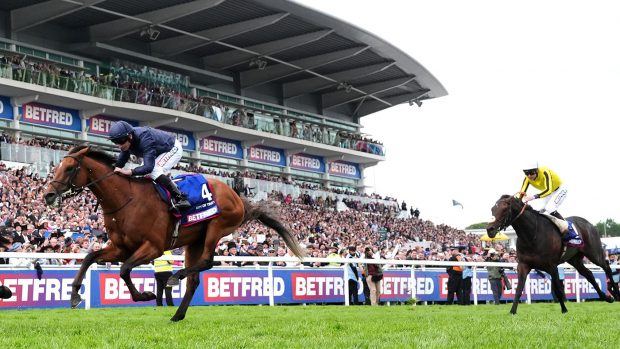Ahead of the 2021 running of the famous Classic at Epsom, Horse & Hound shares some fascinating Derby facts about the prestigious Flat race…
Epsom Derby jockeys and trainers
Lester Piggott has been first past the post in the Derby more times than any other jockey with 9 wins to his name. His winning rides came on Never Say Die (1954), Crepello (1957), St. Paddy (1960), Sir Ivor (1968), Nijinsky (1970), Roberto (1972), Empery (1976), The Minstrel (1977), Teenoso (1983).
Sir Gordon Richards first won the Derby riding Pinza in 1953 — at his 28th attempt. Frankie Dettori didn’t have to wait quite so long — his first win came on his 15th attempt riding Authorized in 2007.
Alex Greaves became the first lady jockey to ride in the race in 1996. She finished last of the 20 runners on the filly Portuguese Lil.

Aidan O’Brien and his 19-year-old son Joseph (pictured above on Camelot) became the first father-son/trainer-jockey combination to win the race in 2012.
Aidan O’Brien became the first trainer to win three Derbys back-to-back in 2014 with Australia. He previously won in 2012 with Camelot and in 2013 with Ruler Of The World.
Three trainers share the title of most successful Derby trainer. Robert Robson trained the winning three-year-old for the seventh time in 1823, John Porter repeated the achievement in 1899, and most recently, Fred Darling collected his seventh win with Owen Tudor in 1941.
Famous Derby winners
Shergar won the race by the longest distance (10 lengths) in 1981 before the colt disappeared without a trace, believed kidnapped by the IRA.

Workforce (pictured above) holds the record for the fastest winning time (2min 31.11sec) from 2010.
Iroquois became the first American-bred horse to win the Derby in 1881.
Ruler Of The World became the first Derby winner wearing sheepskin cheek-pieces in 2013.
Six fillies have won the Derby. The most recent was Fifinella in 1916, who also won the Oaks. The other 5 were Eleanor (1801), Blink Bonny (1857), Shotover (1882), Signorinetta (1908), Tagalie (1912).
The last filly to run in the race was 1,000 Guineas winner Cape Verdi in 1998. She started as 11/4 favourite, but could only finish ninth.

Eleven broodmares can claim two Derby-winning offspring among their progeny, but no mare has produced three winners to date. Urban Sea is the most recent example, giving birth to Galileo (winner in 2001) and Sea The Stars (winner in 2009, pictured above).
In 1828 the race was declares a dead-heat, with Cadland winning a run-off against The Colonel by half a length. There was also a dead-heat in 1884, when Harvester and St. Gatien shared the title.
Minoru was the first Derby winner owned by a reigning monarch, King Edward VII, in 1909. The King had previously won the race twice as Prince of Wales.
The last grey horse to win the Derby was Airborne in 1946.
Derby controversy
The winners in 1844 and 1913 were not the horses first past the post. In 1844, Running Rein was found to be an ineligible 4-year-old horse named Maccabeus. In 1913 the 6/4 favourite Craganour was disqualified in controversial circumstances with the race being awarded to 100/1 outsider Aboyeur.
The 1913 race is more famous for the protest by suffragette Emily Davison, who ran in front of King George V’s horse, Anmer. Emily died of her injuries 4 days later. This wasn’t the first time that a Derby runner had been brought down by a spectator. It also happened in 1805.
Other Epsom Derby facts
A mechanical starting gate was introduced to the Derby in 1901.
The Derby was first broadcast by the BBC in 1927, but regular TV coverage didn’t get established until 1960.
The most runners to ever take part in the race was 34 in 1862, while the smallest field was just 4 in 1794.
Follow all the action ahead of and after the Derby at Epsom here on HorseandHound.co.uk




